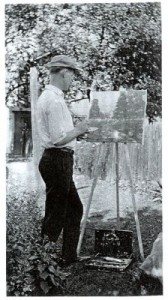 John Lawrence Lloyd was an American impressionist whose most active years were between 1910 and 1950. Lloyd's art work has always received an enormous amount of recognition and a multitude of awards. Noted art critics have always credited him with great artistic talent.
John Lawrence Lloyd was an American impressionist whose most active years were between 1910 and 1950. Lloyd's art work has always received an enormous amount of recognition and a multitude of awards. Noted art critics have always credited him with great artistic talent.
Lloyd painted prolifically and it is quite clear that painting and art were his first passion. He was a lifelong bachelor with the time to travel extensively to art colonies throughout the country. Of particular importance are when he studied under the acclaimed "master" John F. Carlson in Woodstock, New York, and his Philadelphia years – 1915 and 1919 /1922 when he studied with Hugh Breckenridge and Daniel Garber at the Pennsylvania Academy of Fine Arts summer school in Chester Springs, Pennsylvania. The Art Club of Philadelphia, where Lloyd exhibited in 1924, had a reputation of attracting the very best artists from all over the country. Its museums, galleries, and clubs where Lloyd was honored with numerous exhibits, were considered America's best at the time. John Lloyd was a regular visitor there, which was considered by many as one of the best schools in the country for the instruction of "plein air" painting.
Lloyd, 38 years old in 1922, was by then an accomplished artist in his own right; therefore he was not so much a student when traveling, but more of contemporary to most of his instructors. He not only painted alongside them, but also exhibited with them in all of Philadelphia's best museums, galleries, and clubs. Lloyd was highly recognized for his mastery of composition. His landscape "Twin Willows" painted in 1922 at Chester Springs was pronounced by competent critics as "perfect in composition." As a result of Lloyd's impressionistic impasto brushwork and his mastery of composition and use of color, his paintings are "strong and powerful."
Ms. Margo L. Jacobs, a guest curator at the Butler Museum Of American Art, in researching John Lloyd's work, stated the following in 2008:
"Working primarily in oil, Lloyd's plein air-inspired canvases are stylistic representations of the harmony and order of nature, much like the paintings of John Twatchtman, Childe Hassam, and J. Alden Weir. Lloyd's impressionistic landscapes can be properly placed within the continuum of American painting, owing much to the aforementioned painters who were key members in an American impressionist circle known as "The 10." Lloyd's imagery also gives a nod to the Philadelphia impressionists, as well as other prominent and early realist and regionalist works by artists such as Robert Henri and William Glackens."
As an example of this, Dr. William Gerdts (Professor Emeritus of Art History, Graduate School Of The City University of New York, and also Senior Advisor in American Art at the Pennsylvania Academy Of Fine Arts), considered by many as America's top art historian, recently stated that he "enjoys immensely Lloyd's landscapes and his city industrial scenes" and that "Lloyd's pictures are very strong and powerful and wonderfully expressive, especially in their coloration." Lloyd's paintings "are superior works to much that was produced at the time (1920s and 1930s) and much that is being resurrected now."
Despite his notable accomplishments in the first half of the 20th century, Lloyd is relatively unknown by today's scholars and art historians simply because over four-hundred of his paintings have been privately held since the mid-1900's and not readily available to the public. Therefore during the last six decades, John Lloyd has had little or no exhibition history and therefore little publicity at a grand scale.
Through considerable efforts by his family, this has now changed and Lloyd's art work is being re-introduced to the public.
